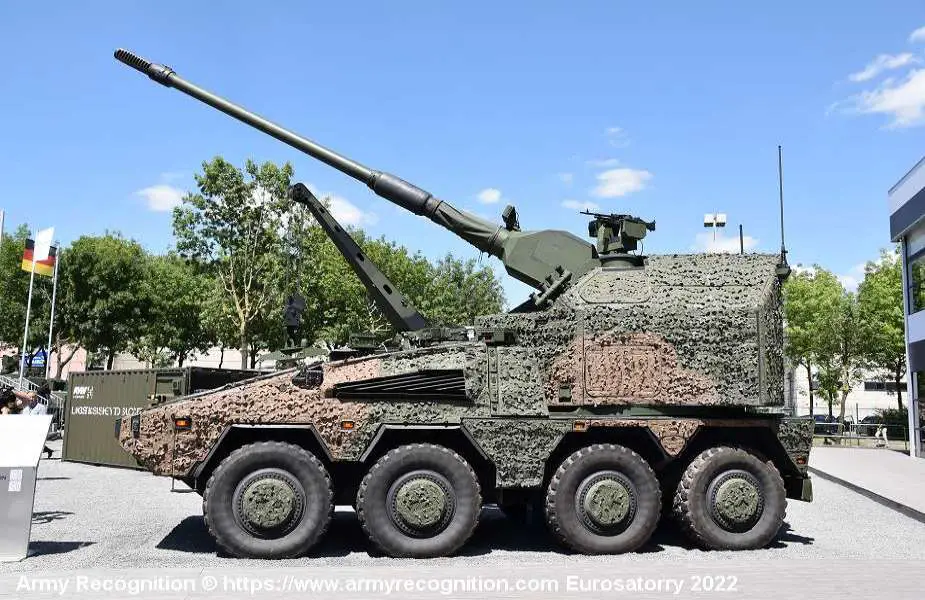Breaking news
German company KNDS offers first fully automated artillery system RCH155 to Ukrainian army.
KNDS, previously known as Krauss-Maffei Wegmann (KMW), will enhance Ukraine's military capabilities by offering the RCH155, a groundbreaking development as the first fully automated artillery system that requires only two crew members, making it particularly suited to current battlefield challenges, including the personnel shortages impacting both Ukraine and Western countries.
Follow Army Recognition on Google News at this link

KNDS's RCH155 is the first fully automated self-propelled artillery system. (Picture source: Army Recognition)
In September 2022, the German government approved the delivery of 18 RCH 155 self-propelled howitzers to Ukraine, in response to a request from the Ukrainian government made in July of the same year. The contract for these howitzers, valued at €216 million, is financed through the German government's Ukraine aid fund, and the deliveries are expected to start in 2024. This system, being the first of its kind with full automation and requiring only a two-person crew, addresses critical challenges like personnel shortages and is apt for modern warfare demands.
The Boxer RCH155 stands out for its advanced automation capabilities. It is equipped with a 155 mm/L52 cannon capable of handling various types of ammunition, including extended-range V-LAP projectiles. This automation extends to its fully automatic loading system and inductive fuze programmer, significantly enhancing its operational efficiency. The RCH155's turret can complete a full 360-degree traverse and adjust its elevation from -2.5° to +65°, allowing for versatile firing missions. The automation of the Boxer RCH155 revolutionizes artillery operations by streamlining the process and reducing crew requirements.
For Ukraine, facing intense warfare and personnel shortages, the arrival of 18 Boxer RCH155 in 2024 would come as a lifeline. With a crew of only two people, this system would enable Ukraine to maximize its combat potential without burdening its human resources, a significant handicap for the Ukrainian army after the wear and tear of the past two years of combat. Its ability to operate with a reduced crew helps to overcome limitations in terms of personnel while maintaining the same firepower on the battlefield. In comparison, older artillery systems like the M777 howitzer, a widely used artillery piece, typically require a crew of at least five to operate effectively. This is due to the manual processes involved in targeting, loading, and firing, which necessitate multiple operators.
The automation of the Boxer RCH155 is at the heart of its revolutionary capabilities. By reducing the necessary crew to just two members, the system maximizes operational efficiency while minimizing the need for human resources. Moreover, this automation translates into a significant increase in reactivity on the ground. The system is capable of quickly and autonomously executing complex tasks, reducing reaction time to threats and allowing for quick and precise decisions in combat situations.
Additionally, its design allows for continuous operations 24 hours a day, by rotating with only two teams, thus minimizing fatigue among combatants and maximizing the use of equipment.
Ukraine is not the only European country for which the Boxer RCH155 would bring a wholly suitable solution. Indeed, European armies are also currently facing an unprecedented recruitment crisis. After Ukraine's acquisition, Germany also decided to purchase the RCH 155 self-propelled howitzer. The German army plans to acquire 168 of these 155 mm wheeled self-propelled howitzers to upgrade its artillery capabilities.
It is also important to mention here the technical capabilities of the Boxer RCH155, which is armed with a 155 mm/L52 cannon, compatible with a wide range of standard NATO munitions.
The RCH 155, evolving from the PzH 2000 self-propelled howitzer, marks a significant leap in artillery technology. The RCH 155 integrates the 155 mm cannon from the PzH 2000 with the Boxer 8x8 armored vehicle. This system, first produced in 2014, boasts a combat weight significantly lower than the PzH 2000, at 39 tonnes. Its fully automated turret, including an enhanced automatic loader, reduces the crew requirement to just two: a driver/operator and a commander. The RCH 155's offensive capabilities include firing up to 9 rounds per minute and employing the Multiple Round Simultaneous Impact (MRSI) technique. Its mobility and shoot-and-scoot capability, coupled with the ability to fire while moving, enhance its tactical advantage on the battlefield.























